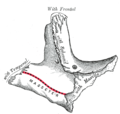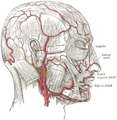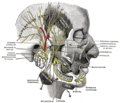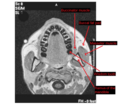Masseter muscle
This articleneeds additional citations forverification.(May 2015) |
| Masseter | |
|---|---|
 The left masseter muscle (red highlight), partially covered by superficial muscles such as theplatysma muscle(below) and both thezygomaticus majorandminor muscles | |
| Details | |
| Origin | Zygomatic archand maxillary process ofzygomatic bone |
| Insertion | Angle surface oframus of mandible,coronoid process |
| Artery | Masseteric artery |
| Nerve | Mandibular nerve(V3) |
| Actions | Elevation(as in closing of the mouth) andprotrusionofmandible |
| Identifiers | |
| Latin | musculas masseter |
| MeSH | D008406 |
| TA98 | A04.1.04.002 |
| TA2 | 2105 |
| FMA | 48996 |
| Anatomical terms of muscle | |
Inanatomy,themasseter[help 1]is one of themuscles of mastication.Found only in mammals, it is particularly powerful inherbivoresto facilitate chewing of plant matter.[5]The most obvious muscle of mastication is the masseter muscle, since it is the most superficial and one of the strongest.
Structure[edit]
The masseter is a thick, somewhat quadrilateral muscle, consisting of three heads, superficial, deep and coronoid. The fibers of superficial and deep heads are continuous at their insertion.
Superficial head[edit]
The superficial head, the larger, arises by a thick, tendinousaponeurosisfrom thezygomatic process of the maxilla,the temporal process of thezygomatic boneand from the anterior two-thirds of the inferior border of thezygomatic arch.Its fibers pass inferior and posterior, to be inserted into the angle of the mandible and inferior half of the lateral surface of theramus of the mandible.
Deep head[edit]
The deep head is much smaller, and more muscular in texture. It arises from the posterior third of the lower border and from the whole of the medial surface of the zygomatic arch. Its fibers pass downward and forward, to be inserted into the upper half of the ramus as high as thecoronoid process of the mandible.The deep head of the muscle is partly concealed, anteriorly, by the superficial portion. Posteriorly, it is covered by theparotid gland.
Coronoid head[edit]
The coronoid head of the masseter's tendon and muscle fibers run posterolaterally from the coronoid process of the mandible towards the posterior third of the zygomatic arch. Its function is believed to be the retraction of the mandible and the stabilization of the mandibular coronoid process.[6][7]
Innervation[edit]
Along with the other threemuscles of mastication(temporalis,medial pterygoid,andlateral pterygoid), the masseter is innervated by the anterior division of themandibular division (V3)of thetrigeminal nerve.The innervation pathway is: gyrus precentralis > genu capsula interna > nucleus motorius nervi trigemini > nervus trigeminus > nervus mandibularis > musculus masseter.
Function[edit]
The action of the muscle during bilateral contraction of the entire muscle is to elevate the mandible, raising the lower jaw. Elevation of the mandible occurs during the closing of the jaws. The masseter parallels themedial pterygoid muscle,but it is stronger and superficial fibres can cause protrusion.
Clinical significance[edit]
Pathology[edit]
The masseter muscle can become enlarged in patients who habitually clench or grind (withbruxism) their teeth and even in those who constantly chew gum. This masseterichypertrophyis asymptomatic and soft; it is usually bilateral but can be unilateral. Even if the hypertrophy is bilateral, asymmetry of the face may still occur due to unequal enlargement of the muscles. This extraoral enlargement may be confused with parotid salivary gland disease, dental infections, and maxillofacial neoplasms. However, no other signs are present except those involved in changes in occlusion intraorally such as pain, and the enlargement corresponds with the outline of the muscle. Most patients seek medical attention because of comments about facial appearance, and this situation may be associated with further pathology of thetemporomandibular joint.[8]
Finally, the muscle undergoes spasm withmalignant hyperthermiaas do otherskeletal muscles,but this one is easily noted, since it is on the face.
Singersoften experience various kinds of masseter tension, which is often treated with transdermal massages or stretches as avocal warm-up.[9][10]
In other animals[edit]
The masseter muscle's positioning is a distinguishing feature ofhystricognathouscreatures such asmole-rats,where it passes partially through theinfraorbital foramenand connects to the bone on the opposite side.
Intoothed whales,the masseter muscle, made redundant due to a shift in ingesting food from chewing to swallowing, provides the tissue for acoustic fat bodies, including themelon,used forecholocation.[11]
Additional images[edit]
-
Muscles of the head and neck.
-
Dissection, showing salivary glands of right side (Masseter visible at center)
-
Left temporal bone, outer surface
-
Left temporal bone, inferior surface
-
Left zygomatic bone, temporal surface
-
Mandible, outer surface, side view
-
The arteries of the face and scalp.
-
Veins of the head and neck.
-
Mandibular division of the trifacial nerve.
-
Masseter muscle. Deep dissection. Mummification process.
-
An MRI of head with captions for masseter muscle and other structures around it
See also[edit]
Notes[edit]
- ^The wordmasseter(usually/məˈsiːtər/,[1][2][3]sometimes/ˈmæsɪtər/[4]) comes throughNeo-LatinfromGreekμασᾶσθαιmasasthai,"to chew".
References[edit]
- ^Elsevier,Dorland's Illustrated Medical Dictionary,Elsevier.
- ^Merriam-Webster,Merriam-Webster's Medical Dictionary,Merriam-Webster.
- ^Houghton Mifflin Harcourt,The American Heritage Dictionary of the English Language,Houghton Mifflin Harcourt, archived fromthe originalon 2015-09-25,retrieved2015-09-27.
- ^Wolters Kluwer,Stedman's Medical Dictionary,Wolters Kluwer.
- ^Romer, Alfred Sherwood; Parsons, Thomas S. (1977).The Vertebrate Body.Philadelphia, PA: Holt-Saunders International. p. 283.ISBN0-03-910284-X.
- ^Mezey, Szilvia E.; Müller-Gerbl, Magdalena; Toranelli, Mireille; Türp, Jens Christoph (2022-02-01)."The human masseter muscle revisited: First description of its coronoid part".Annals of Anatomy - Anatomischer Anzeiger.240:151879.doi:10.1016/j.aanat.2021.151879.ISSN0940-9602.PMID34863910.S2CID244844284.
- ^Mudry, Albert; Jackler, Robert K. (2022-08-01)."The coronoid insertion of the human masseter muscle was well described in the 18th century".Annals of Anatomy - Anatomischer Anzeiger.243:151922.doi:10.1016/j.aanat.2022.151922.ISSN0940-9602.PMID35278659.S2CID247374798.
- ^Illustrated Anatomy of the Head and Neck, Fehrenbach and Herring, Elsevier, 2012, p. 97
- ^"Mix it up Monday: Releasing the masseter muscle".14 December 2015.
- ^Kayes, Gillyane (2000).Singing and the Actor.ISBN978-0878301980.
- ^Takeuchi, Hayate; Matsuishi, Takashi Fritz; Hayakawa, Takashi (2024). "A tradeoff evolution between acoustic fat bodies and skull muscles in toothed whales".Gene.901:148167.doi:10.1016/j.gene.2024.148167.











